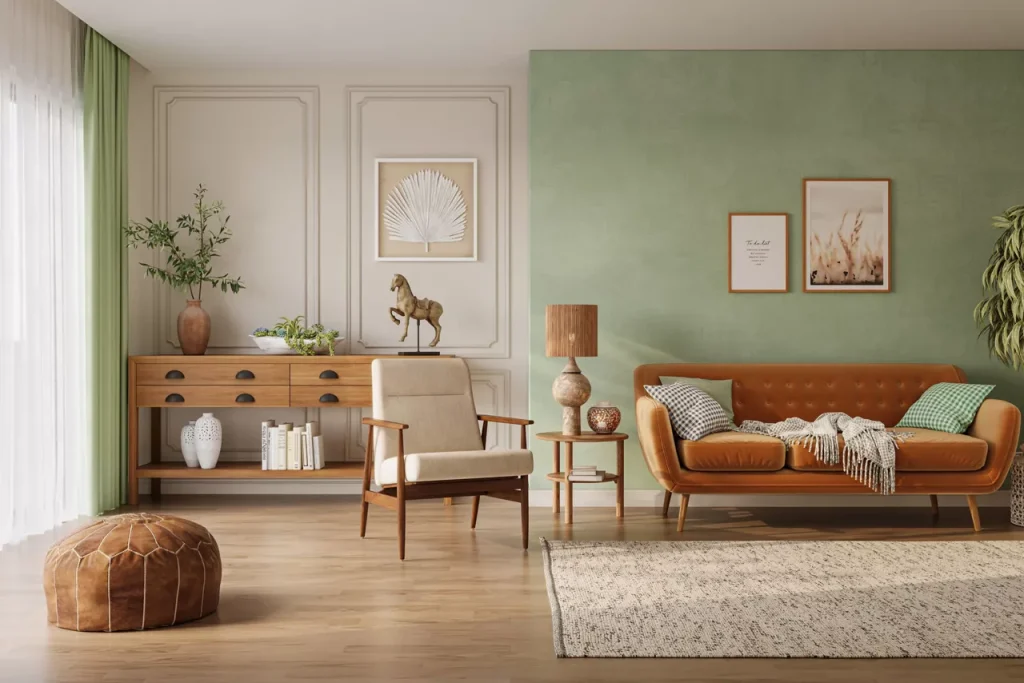Choosing the right room colour combination can completely transform the vibe of your living room. One of the most effective techniques for achieving this is the dual-tone paint method. It not only adds depth and contrast to a space but also enhances visual interest without overwhelming the room.
Whether exploring new interior colour for homes or updating the current style, dual-tone walls offer a versatile and modern approach to elevate your interiors.
Let’s walk you through a step-by-step guide on how to use dual-tone paints effectively in your living room, including expert tips and tricks for a polished finish.
Set the Tone – Paint the Upper Half First
When working with dual-tone paints, always start with the top section of the wall, as it is the most visible area. This sets the stage for your design and prevents any unwanted drips onto a freshly painted bottom.
Before you begin, decide on the mood you want to create. Lighter shades, such as soft beige, pastel blue, or creamy white, can make a space feel open and airy. These tones work wonderfully for the upper section as they help reflect natural light and give your living room a taller appearance.
For a more dynamic visual appeal, consider modern texture paint designs like brushed or sponge finishes. A lightly textured upper wall creates contrast when paired with a smoother bottom section, adding both depth and dimension.
Use premium emulsion paint with a matte finish for the upper half for a chic, contemporary look. Remember, the top tone should always be painted first and allowed to dry completely before proceeding to the next step.
Define the Divide – Use Painter’s Tape for Precision
Once the upper wall section is completely dry, it’s time to create a clean, sharp boundary for your dual-tone design. This is where painter’s tape becomes your best friend.
Measure the height where you want the colour divide. Typically, the split is made at chair-rail height (approximately 3 feet from the floor), but you can adjust it higher or lower depending on your design preference.
Stick the tape horizontally along the chosen line using a level to ensure perfect alignment. Press the edges of the tape firmly to prevent any colour bleeding when you apply the second paint layer.
If you’re using modern texture paint designs on either section, taping off that texture can be a bit tricky. In that case, consider using a subtle trim or moulding to mask any rough dividing lines and add an extra design feature to your wall.
A navy blue or charcoal lower section paired with an off-white or muted grey top section creates a stylish, modern contrast that is perfect for urban homes.
Ground the Look – Paint the Lower Half in a Bold or Earthy Shade
With the upper section complete and the dividing tape in place, it’s time to paint the bottom section of your wall. This is where you can introduce a richer, bolder colour to ground the space and enhance its depth.
Darker colours work great here – think deep greens, rich browns, slate greys, or even burnt terracotta. These shades not only provide visual weight but also resist scuffing and wear, making them perfect for the lower half.
When choosing the second interior colour for homes, ensure it complements the upper tone. Opposites on the colour wheel often pair well, or you could try a monochromatic scheme using different shades of the same hue.
Add wainscoting or wooden panelling to the bottom half before painting. It adds texture and sophistication to the overall look, especially if you’re aiming for a fusion of vintage and modern texture paint designs.
Perfect the Palette – Add Finishing Touches and Decor
Once both tones are painted and fully dry, peel off the painter’s tape slowly and evenly to reveal a crisp, clean line. Any minor touch-ups can be done with a fine brush to ensure perfection.
Now, complete your dual-tone transformation by incorporating decor elements that echo your chosen room colour combination. Cushions, rugs, curtains, and even artwork should be selected to align with the wall palette, creating a cohesive visual flow.
Mirrors and metallic accents, like gold or brass fixtures, can further enhance the depth created by your dual-tone walls. Likewise, layered lighting, such as floor lamps, pendant lights, or wall sconces, can accentuate both paint tones and add dimension during different times of the day.
When experimenting with interior colour for homes, dual-tone walls in the living room are a great way to experiment without overwhelming the entire space. It also allows you to express two different moods – calm and airy above, bold and grounded below – in one seamless look.
Final Thoughts: Why Dual-Tone Walls Are a Smart Design Choice
Using dual-tone paints in your living room is more than just a trend – it’s a smart way to play with proportions, add personality, and bring depth to your space.
Combining thoughtful room colour combinations, high-quality paint, and a bit of creativity can result in a truly striking living room makeover.
Don’t shy away from experimenting with textures or unusual pairings – sometimes the boldest choices bring the best results.

